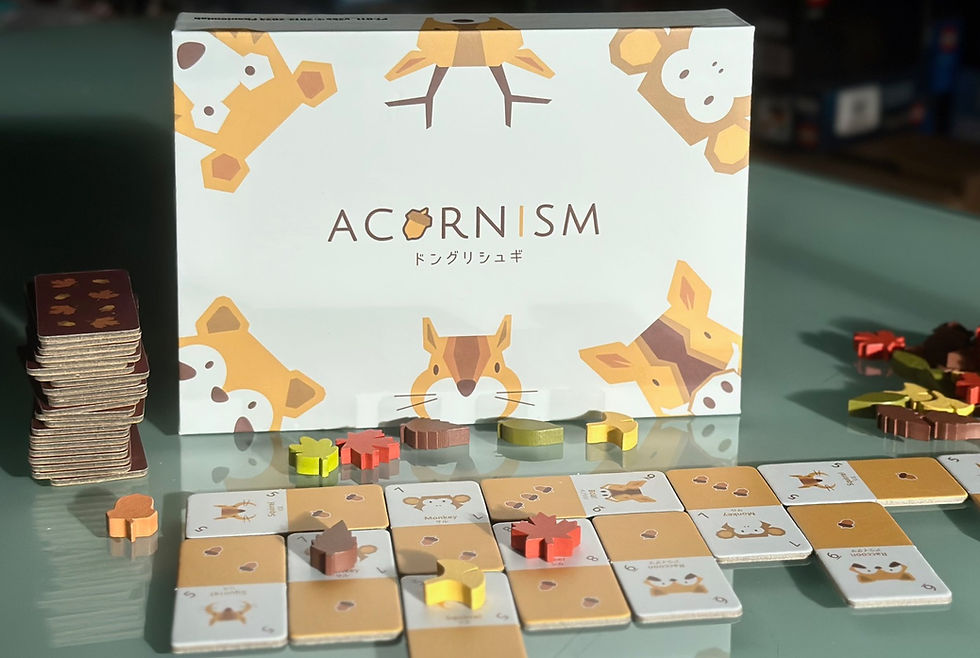Santa Monica
- Toby Hicks
- Oct 29, 2021
- 3 min read
The first thing you notice about Santa Monica is the artwork by Jeremy Nguyen and game designer Josh Wood. Love it or not, it is certainly unique and striking. Beautiful pastel-colours with a relaxed, cartoon style. It looks nothing like any other game I have played and, to be honest, I love it!
Published by AEG, Santa Monica is a light-to-midweight game for 2-4 players with a strong focus on adjacency and creating combos, and demanding a fair amount of forward planning.

During the game, players take turns placing cards into a tableau in front of them with the aim of creating a beach and street/boardwalk that scores the most points. Cards will score points based on a number of factors, most based on total number of cards of a set type, adjacency or in combination with other cards. Points will also be scored by moving various character meeples around your tableau, with different kinds having different requirements. Foodies will want to be moved into restaurants or food trucks, locals will want to be placed on local amenities and tourists might wish to be on the beach playing or ogling volleyball.
Cards are split into a number of categories, such as tourist, decorative or commercial and each will score points depending on a wide range of factors. For example, a commercial card may score bonus points if in a row of three commercial buildings, whereas a tourist card's score may be dependant on access to both decorative and commercial buildings. Cards are placed into the tableau, forming two lines of 7 cards, for a total of 14. Once the final card has been placed, the game is over and players score.
You draw from the bottom of the two rows of face-up cards that are placed in the centre of the board. The upper card is then moved down to fill the vacant space and a new card drawn from the deck and placed in the top space. Next to the face-up cards there are two 'sand dollar' action tokens. These are drawn randomly at the start of the game and add some special actions that can be performed by players, such as moving meeples around or drawing/exchanging cards. These special actions are paid for using 'sand dollars' which can be acquired by playing certain cards.
When a card is placed into your tableau you will gain, in most cases, an immediate benefit. This will usually be a combination of sand dollars and meeples, placed on to the card you have just played. They can then be moved, ideally into a scoring position using the sand dollar actions.
As your tableau grows you will have more spaces into which you can play but also potentially more restrictions. The higher-scoring cards often require multiple cards of a certain type being connected to each other and this will drastically change what cards you choose to pick up and where you lay them. Do you try to stick to a rigid plan, relying on some potentially high-scoring cards at the expense of flexibility and the risk of failing to meet the criteria? Do you play open: trying to get flexible combinations of cards that can take advantage of multiple scoring criteria at the risk of being too disjointed? Then again you can always choose to focus on your meeples, choosing cards that give you the most meeples, buildings they combine with to score and sand dollars to move all these pieces into place...
Santa Monica is one of those games that starts off very, very simply, but rapidly spirals into dozens of possible card choices, placements and scoring combinations, all of which evolve and get more complex with every round. In the end, it can be as simple or as complicated as you choose to make it, but fans of planning-heavy games will find much to enjoy here. The variety of options, randomised sand-dollar actions and gorgeous artwork make this an understated gem of a game. It plays very well with two players and it works just as well with three or four, though increasing the number of players increases the play time to 90 minutes or more, especially if any of the players are prone to analysis paralysis.
Overall Santa Monica is a delightful little game with a strong theme, engaging art and a level of depth that quite belies its cheerful, pastel-hued appearance.
(Review by Toby Hicks)




